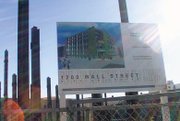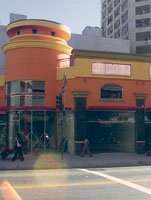Bucking Trends in Fashion Markets
Real estate prices in key fashion markets may become a little pricier in 2006.
Rising construction and energy costs have put pressure on landlords and developers to raise rents.
The recent sellers’ market that saw two major buildings in the Los Angeles Fashion District change hands this year along with dozens of major shopping centers is expected to continue to a lesser degree, said real estate experts. The cost of doing business is to blame. Many construction materials are oil-based and their cost has spiked 25 to 40 percent. Concrete and steel prices have risen similarly.
Case in point: A major investor in the L.A. Live entertainment, retail and residential project being planned a few blocks west of the Los Angeles Fashion District, withdrew its financing for a Hilton-operated hotel next to the Los Angeles Convention Center because of rising construction costs, which have soared to an estimated $500 million from $350 million.
Other events such as the hurricanes on the Gulf Coast have pulled labor away from the West Coast, contributing to a rise in labor costs as well. Add in higher energy and fuel costs and developers and building owners are clearly facing obstacles to new construction. These factors trickle down to leasing and resales, which concerns many of the business owners within the apparel industry.
Fashion District frenzy
Despite the obstacles, there’s plenty of steel and concrete being shuffled about in the Los Angeles Fashion District.
Retail and wholesale space continue to be gobbled up at a record pace as a result of demand for premium showroom space in the contemporary market and a bustling discount trade in the Fashion District’s sub-market along Santee, Maple and San Pedro streets.
Sales for wholesale condominiums at the new L.A. FACE project at 1444 S. San Pedro St. are averaging about $375 per square foot, according to the developer, L.A. Properties Investment and Management. That’s $450,000 for a 1,200-square-foot showroom. The unique aspect about the project is that tenants take an ownership role in their spaces. The project, when completed next year, will bring 200 units of more than 650,000 square feet to the district.
It’s just one of several projects under development in the area. Others include a retail center at Pico and Maple streets; 1000 Maple Center at Olympic and Maple, a 15,000-square-foot retail center by the KI Group; and several projects planned near San Pedro and Stanford streets. Lease rates are up to $20 per square foot for some of the newer projects, but price doesn’t appear to be a major obstacle.
“That whole area has really taken off and the thing is that it’s all being built on spec. The demand exists. Absorption is at capacity,” said Kent Smith, executive director of the Fashion District Business Improvement District.
A lot of the business is being fueled by discount fashion in the juniors and accessories sectors on the wholesale side and all-around business on the retail side.
Smith said weekend traffic along Santee Alley and neighboring thoroughfares has been growing rapidly. “Some of the unofficial barometers we [use are] the amount of trash we have to pick up and the hits we get through our Web site, which is now at more than 2 million hits a month,” Smith said.
In the main hub of the Fashion District, now known as The Intersection, where the California Market Center, The New Mart, the Gerry Building and Cooper Design Space are located, leasing activity continues to heat up. Both the CMC and Gerry were sold this year, and the sellers reaped substantial profits.
Los Angeles–based office-property specialist Jamison Properties Inc., which purchased the CMC for about $135 million from Hertz Investments in May, has not wasted any time on rebranding its new project. The company has launched a remodel of its 110,000-square-foot penthouse floor, where it will create a new 75,000-square-foot exhibition space as well as 35,000 square feet of new showroom space. The remodeled space is expected to open over two phases in January and April 2006.
The CMC, at an estimated 75 percent occupancy rate, still has lots of showroom space to fill and may benefit from the overflow from neighboring buildings once they reach capacity, which is expected sometime in 2006. Nevertheless, the center signed some big-league tenants over the past year, including Puma, Ben Sherman, Da Vinci, English Laundry, Fender, Anna Paul, ZNJ, Beau & Co., 6 Degrees, RVX, Beija Brazil and The Doneger Group buying office.
Aside from leasing activity, the CMC has ramped up its trade-show effort, creating a solid mix of markets for buyers. The recent October market was the strongest in 10 years.
The nearby Gerry Building was also the subject of a sale when Manhattan Beach, Calif.–based LaeRoc Partners paid about $14 million for the nine-story Art Deco building this summer.
The Gerry is expected to reach 85 percent occupancy, having just signed a number of key leases, including Sixty USA, the Italian firm that markets Miss Sixty, Energie and a number of other contemporary labels. Also new to the building are Nektar, Josette, Drifter and GDK Sales. Jameric, which markets True Religion in Asia, is also a new tenant. Also closing in on leaseup is the Cooper Design Space, which has attracted about 60 tenants since it began marketing showroom space less than two years ago.
The Cooper recently signed 7 for All Mankind as well as Findings, a multi-line showcase.
“We have a great community here,” said Cooper leasing manager Mona Sangkala. “And the space is great with high ceilings and concrete floors.”
The presence of the Gerry Building and the Cooper Design Space has brought buyers new options over the past couple of years.
“Everything is getting spread around more to the smaller buildings, which is good for buyers. They are going to be taken care of,” said Larry Hudson, general manager of the Gerry Building. Hudson said that with fewer leasing opportunities, building managers tend to turn efforts toward service.
Housing is hot
Elsewhere in the Fashion District, residential construction continues apace. MJW Investments is working on the final two phases of Santee Court, an 800,000-squarefoot residential complex along Los Angeles Street. MJW sold Phase I to a pension fund group this year. Two other phases include 64 and 216 condominiums. The company is also developing a mixed-use project next to the historic Sears building in the Boyle Heights neighborhood east of downtown Los Angeles, where 772 units are planned. The development is in environmental review and is expected to be approved next year. MJW recently reached an agreement with L.A. Family Housing to designate about 20 percent of the units for affordable housing.
Even with rising interest rates, MJW President Mark J. Weinstein sees a positive market for future housing in areas such as downtown Los Angeles.
“There is still an upside. There’s lots of interest,” he said. “There’s not a lot available, but there’s a lot being built. The supply is not unlimited yet. With all the things like L.A. Live and the Grand Avenue Historic Core project on the horizon, it creates a better place, and that creates demand.”
Steve Needleman, who quickly sold out his Orpheum Lofts last year, thinks the current market conditions won’t make it as easy to develop ground-up properties.
“With all the bond issues and demand for labor, you have to pay top dollar. Yet, there’s been so much money flowing into downtown and the economic base is solid,” he said.
Needleman’s company sold its famed Olympic Auditorium earlier this year to the Glory Church of Jesus Christ for an undisclosed sum. The venue was once a famous boxing hall that was used during the 1932 Olympic Games. Recently, it has served as the site of events including the VH1 Awards. The company owns the Orpheum Theatre, which has served the L.A. fashion community as the site of the L.A. Fashion Awards as well as Fashion Week shows. The venue will host events for TV’s “American Idol” and the Comedy Central cable network, Jamie Foxx’s “Unpredictable” one-hour TV special, the Grammy Awards’ “Grammy Jam” and the Ovation Awards, which honor local theater.
The new residential element downtown has also created other opportunities.
Within a few years of opening downtown L.A.’s Golden Gopher nightclub, Cedd Moses opened the Broadway Bar near the Orpheum, bringing new night life to the area. Restaurateur Fred Eric of Fred 62 fame will open the Tiara Cafeacute; next to The New Mart in February. The restaurant is expected to cater to the evening crowd as well as the lunch folk.
Prime market for retail
Prime retail streets are continuing to reap substantial rents. Robertson Boulevard properties command rates of about $10 per square foot, and Melrose Avenue sites between Doheny Drive and Fairfax Avenue are averaging $5 to $7 per square foot.
“Parts of Beverly Hills are getting too expensive, and [people are] heading to west Melrose to remedy that,” said Robb Bader, a leasing executive with Sachse Real Estate Co. in Beverly Hills.
The entry of such big names as Marc Jacobs and Diane Von Furstenberg has boosted west Melrose, and rates have reflected that, with increases of about 10 to 20 percent over the past year, Bader said.
“Retail is still in vogue,” added Paul Mittmann, vice president of acquisition for Passco Real Estate in Irvine, Calif. Mittman said cap rates have compounded 57 basis points over the past year, but he added that the increases in construction, labor and energy prices are starting to take their toll on real estate developers and owners.
“They’re going to need higher rents to make these deals work,” he said.
In the suburbs, Mittman said there would be pressure to continue the “de-malling” of America by upgrading older malls into lifestyle centers. Mittman said Wal-Mart, Target and others are also becoming more creative with their real estate planning, moving into nontraditional markets such as suburban shopping malls and the inner city. Those and other retailers have also been taking over vacancies left by retailers who have downsized. Yet others are looking to expand.
San Francisco’s retail scene is rebounding from the effects of the technology industry shakeout as well as the post-9/11 tourism crash.
The market has recently seen the entry of Swedish discount retailer H&M. A Bloomingdale’s flagship will open next year, and Barneys New York reportedly is eyeing a Union Square location vacated by toy retailer FAO Schwarz. The 60,000-square-foot space on Stockton Street would be the retailer’s first entry into the Bay Area market.
The Federated Department Stores/May Co. merger is also changing the retail landscape in California. Federated said it is closing its Robinsons-May in Beverly Hills and at Orange County’s South Coast Plaza. The Orange County store will become a Bloomingdale’s.























